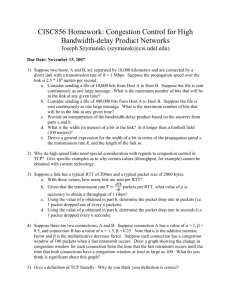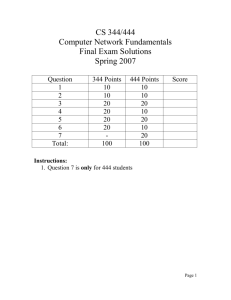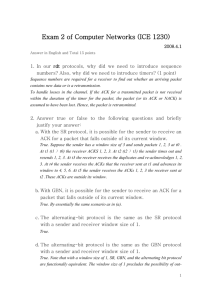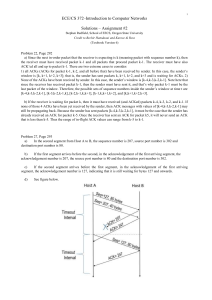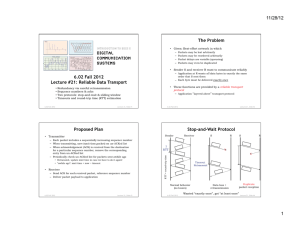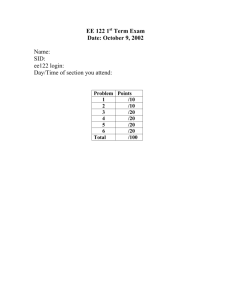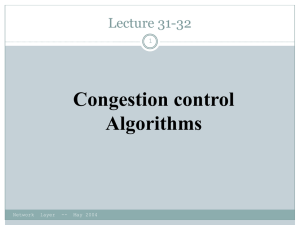Problem 27
advertisement
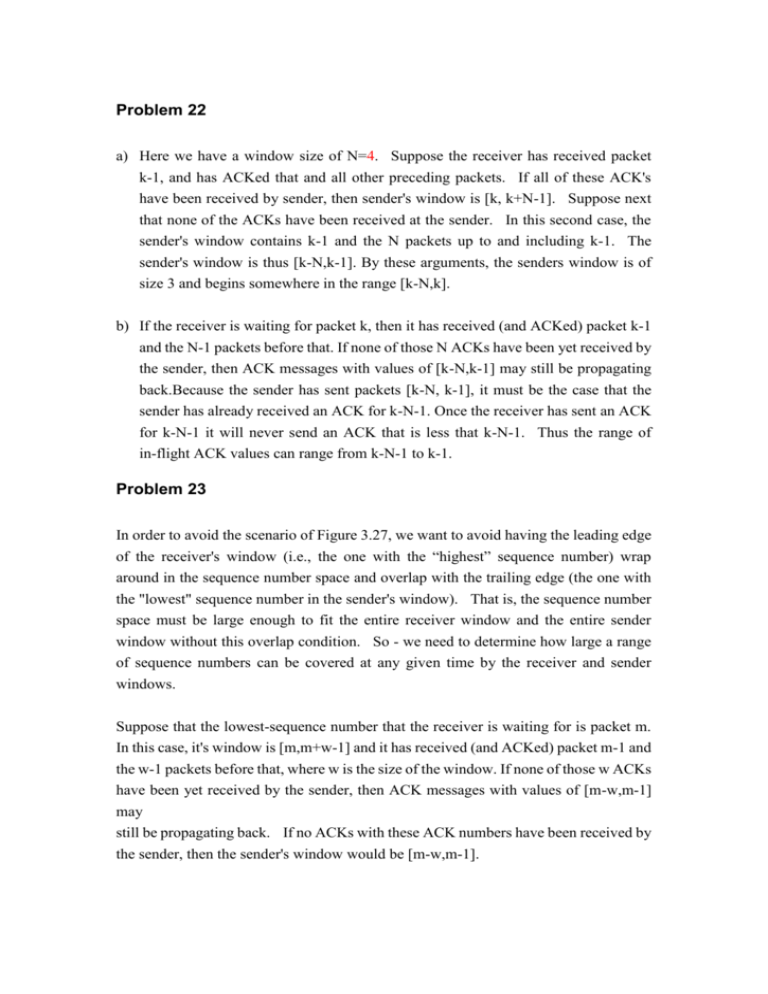
Problem 22 a) Here we have a window size of N=4. Suppose the receiver has received packet k-1, and has ACKed that and all other preceding packets. If all of these ACK's have been received by sender, then sender's window is [k, k+N-1]. Suppose next that none of the ACKs have been received at the sender. In this second case, the sender's window contains k-1 and the N packets up to and including k-1. The sender's window is thus [k-N,k-1]. By these arguments, the senders window is of size 3 and begins somewhere in the range [k-N,k]. b) If the receiver is waiting for packet k, then it has received (and ACKed) packet k-1 and the N-1 packets before that. If none of those N ACKs have been yet received by the sender, then ACK messages with values of [k-N,k-1] may still be propagating back.Because the sender has sent packets [k-N, k-1], it must be the case that the sender has already received an ACK for k-N-1. Once the receiver has sent an ACK for k-N-1 it will never send an ACK that is less that k-N-1. Thus the range of in-flight ACK values can range from k-N-1 to k-1. Problem 23 In order to avoid the scenario of Figure 3.27, we want to avoid having the leading edge of the receiver's window (i.e., the one with the “highest” sequence number) wrap around in the sequence number space and overlap with the trailing edge (the one with the "lowest" sequence number in the sender's window). That is, the sequence number space must be large enough to fit the entire receiver window and the entire sender window without this overlap condition. So - we need to determine how large a range of sequence numbers can be covered at any given time by the receiver and sender windows. Suppose that the lowest-sequence number that the receiver is waiting for is packet m. In this case, it's window is [m,m+w-1] and it has received (and ACKed) packet m-1 and the w-1 packets before that, where w is the size of the window. If none of those w ACKs have been yet received by the sender, then ACK messages with values of [m-w,m-1] may still be propagating back. If no ACKs with these ACK numbers have been received by the sender, then the sender's window would be [m-w,m-1]. Thus, the lower edge of the sender's window is m-w, and the leading edge of the receivers window is m+w-1. In order for the leading edge of the receiver's window to not overlap with the trailing edge of the sender's window, the sequence number space must thus be big enough to accommodate 2w sequence numbers. That is, the sequence number space must be at least twice as large as the window size, k 2w . Problem 27 a) In the second segment from Host A to B, the sequence number is 207, source port number is 302 and destination port number is 80. b) If the first segment arrives before the second, in the acknowledgement of the first arriving segment, the acknowledgement number is 207, the source port number is 80 and the destination port number is 302. c) If the second segment arrives before the first segment, in the acknowledgement of the first arriving segment, the acknowledgement number is 127, indicating that it is still waiting for bytes 127 and onwards. d) Host B Host A Seq = 127, 80 bytes Timeout interval Seq = 207, 40 bytes Ack = 207 Ack = 247 Seq = 127, 80 bytes Timeout interval Ack = 247 Problem 32 a) Denote EstimatedRTT (n ) for the estimate after the nth sample. EstimatedRTT ( 4) x S a m p l e RT 1 T (1 x)[ xSampleRTT2 (1 x)[ xSampleRTT3 (1 x)SampleRTT4 ]] xSampleRTT1 (1 x) xSampleRTT2 (1 x) 2 xSampleRTT3 (1 x) 3 SampleRTT 4 b) n 1 EstimatedRTT ( n ) x (1 x) j 1 SampleRTT j j 1 (1 x) n 1 S a m p l e RTn T c) EstimatedRTT ( ) x (1 x ) j SampleRTT j 1 x j 1 1 j .9 S a m p l e RTj T 9 j 1 The weight given to past samples decays exponentially. Problem 40 a) TCP slowstart is operating in the intervals [1,6] and [23,26] b) TCP congestion avoidance is operating in the intervals [6,16] and [17,22] c) After the 16th transmission round, packet loss is recognized by a triple duplicate ACK. If there was a timeout, the congestion window size would have dropped to 1. d) After the 22nd transmission round, segment loss is detected due to timeout, and hence the congestion window size is set to 1. e) The threshold is initially 32, since it is at this window size that slow start stops and congestion avoidance begins. f) The threshold is set to half the value of the congestion window when packet loss is detected. When loss is detected during transmission round 16, the congestion windows size is 42. Hence the threshold is 21 during the 18th transmission round. g) The threshold is set to half the value of the congestion window when packet loss is detected. When loss is detected during transmission round 22, the congestion windows size is 26. Hence the threshold is 13 during the 24th transmission round. h) During the 1st transmission round, packet 1 is sent; packet 2-3 are sent in the 2nd transmission round; packets 4-7 are sent in the 3rd transmission round; packets 8-15 are sent in the 4th transmission round; packets 16-31 are sent in the 5th transmission round; packets 32-63 are sent in the 6th transmission round; packets 64 – 96 are sent in the 7th transmission round. Thus packet 70 is sent in the 7th transmission round. i) The congestion window size is 8, the threshold is half the current value of the congestion window size = 4. j) The threshold will be set to half the current value of the congestion window (8) when the loss occurred and congestion window will be set to the new threshold value + 3 MSS . Thus the new values of the threshold and window will be 4 and 7 respectively. Threshold is 21, and congestion window size is 1. k) round 17, 1 packet; round 18, 2 packets; round 19, 4 packets; round 20, 8 packets; round 21, 16 packets; round 22, 21 packets. So, the total number is 52. Problem 45 a) The loss rate, L , is the ratio of the number of packets lost over the number of packets sent. In a cycle, 1 packet is lost. The number of packets sent in a cycle is W /2 W W W 1 W ( n) 2 2 n 0 2 W W W /2 1 n 2 2 n 0 W W W / 2(W / 2 1) 1 2 2 2 W2 W W2 W 4 2 8 4 3 3 W2 W 8 4 Thus the loss rate is L 1 3 2 3 W W 8 4 b) For W large, 8 3 2 3 . From the text, we W W . Thus L 8 / 3W 2 or W 8 4 3L therefore have average throughput 3 8 MSS 4 3L RTT 1.22 M S S RT T L Problem 56 a) Referring to the figure below, we see that the total delay is RTT + RTT + S/R + RTT + S/R + RTT + 12S/R = 4RTT + 14 S/R b) Similarly, the delay in this case is: RTT+RTT + S/R + RTT + S/R + RTT + S/R + RTT + 8S/R = 5RTT +11 S/R c) Similarly, the delay in this case is: RTT + RTT + S/R + RTT + 14 S/R = 3 RTT + 15 S/R initiate TCP connection request object first window = S/R RTT second window = 2S/R third window = 4S/R fourth window = 8S/R complete transmission object delivered time at
